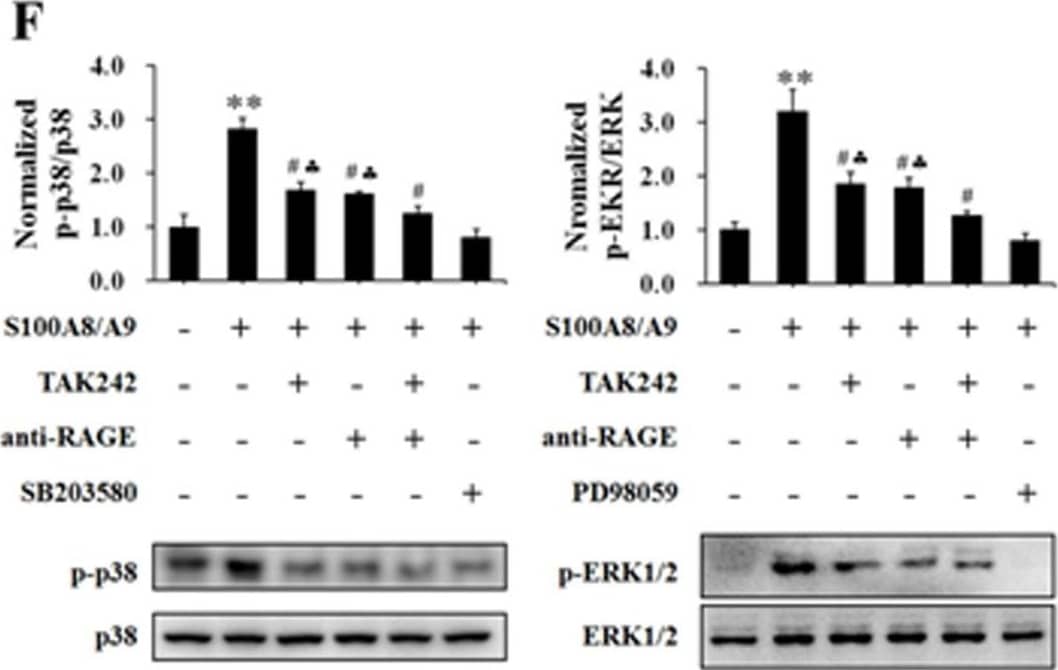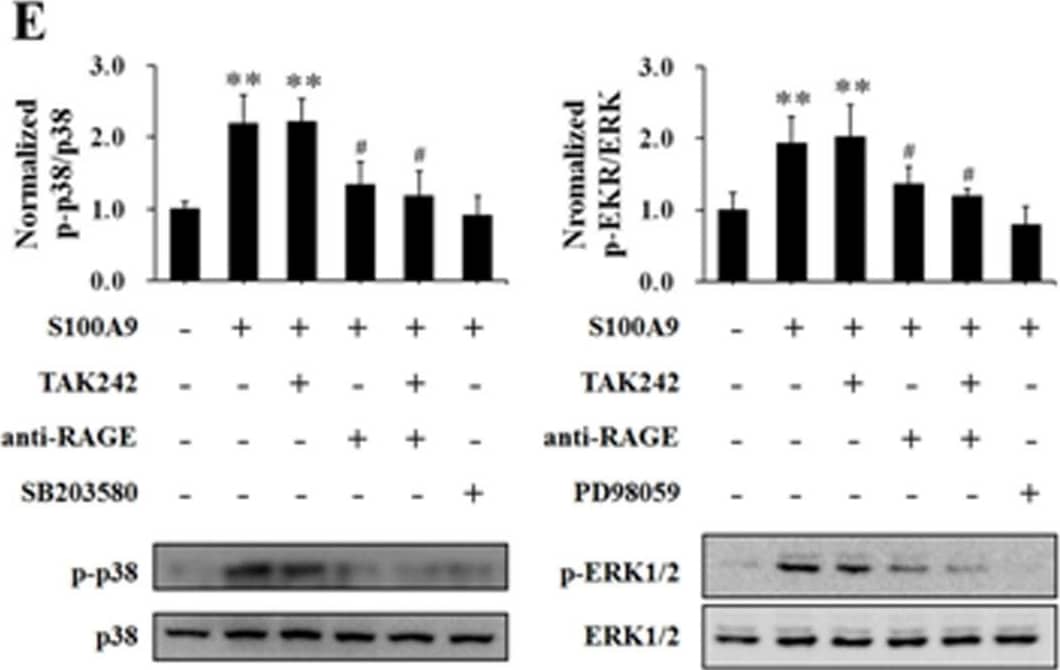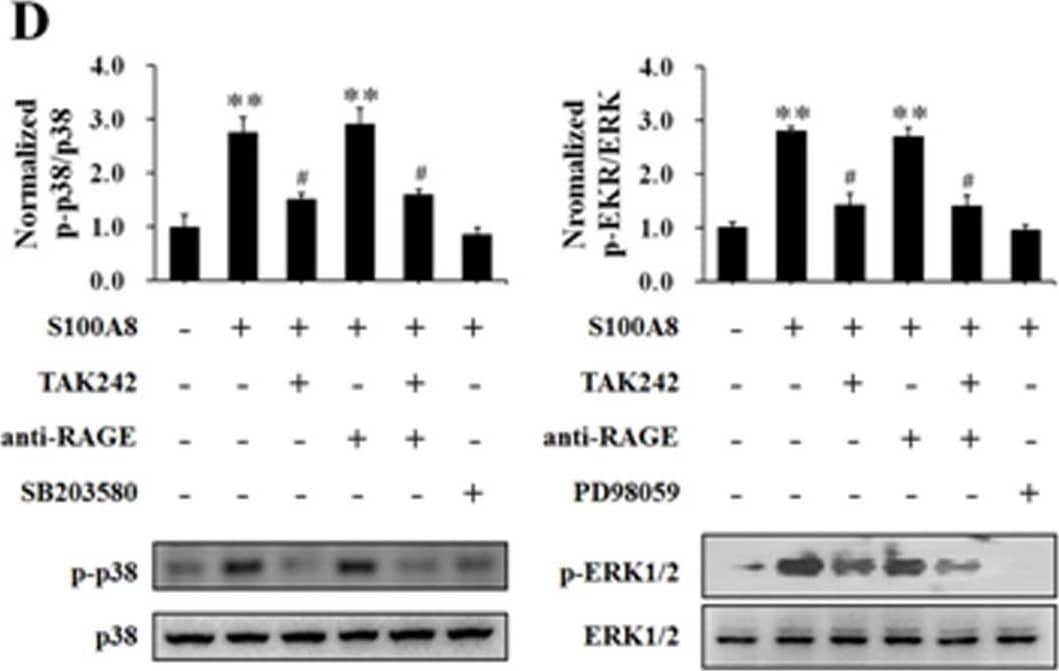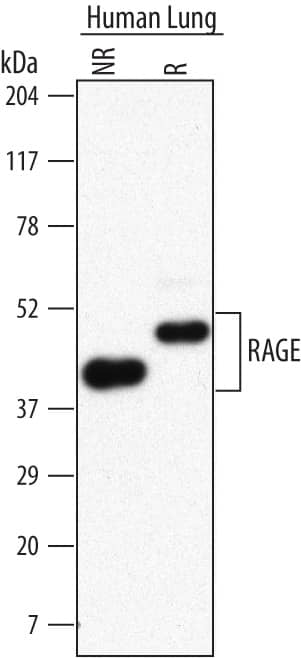Human RAGE/AGER Antibody
R&D Systems, part of Bio-Techne | Catalog # MAB11451

Key Product Details
Species Reactivity
Validated:
Cited:
Applications
Validated:
Cited:
Label
Antibody Source
Product Specifications
Immunogen
Gln24-Ala344
Accession # Q15109
Specificity
Clonality
Host
Isotype
Endotoxin Level
Scientific Data Images for Human RAGE/AGER Antibody
Detection of Human RAGE by Western Blot.
Western blot shows lysates of human lung tissue. PVDF Membrane was probed with 2 µg/mL of Mouse Anti-Human RAGE Monoclonal Antibody (Catalog # MAB11451) followed by HRP-conjugated Anti-Mouse IgG Secondary Antibody (Catalog # HAF007). Specific bands were detected for RAGE at approximately 43 kDa under non-reducing (NR) conditions and 50 kDa under reducing (R) conditions (as indicated). This experiment was conducted under reducing conditions and using Immunoblot Buffer Group 1.Detection of AGER by Western Blot
The effects of blocking TLR4 and RAGE on S100A8, S100A9 and S100A8/A9 stimulation of HUVECs.HUVECs were stimulated with S100A8 (2.0 µg/mL) (A, D), S100A9 (2.0 µg/mL) (B, E) and S100A8/A9 (2.0 µg/mL) (C, F) for 120 min with or without 60 min pre-incubation with specific blockers (TAK242 (5 µM) for TLR4 and anti-human RAGE antibody (10 µg/mL) for RAGE). Then the TER was measured (A, B and C). All data are presented as mean ± s.d. of four independent experiments. Phosphorylation of p38 (p-p38) and ERK1/2 (p-ERK1/2) were also assessed by Western blotting (D, E and F). The ratio of immunointensity between the phosphorylation of p38 and ERK1/2 (p-p38 and p-ERK) and total p38 and ERK1/2 (p38 and ERK) were calculated (D, E and F). The results are expressed in mean ± s.d. from three independent experiments. **P<0.01 vs. Control; #P<0.05 vs. S100A8/S100A9; ♣P<0.05 vs. S100A8/S100A9+TAK242+anti-RAGE. Image collected and cropped by CiteAb from the following open publication (https://pubmed.ncbi.nlm.nih.gov/24595267), licensed under a CC-BY license. Not internally tested by R&D Systems.Detection of AGER by Western Blot
The effects of blocking TLR4 and RAGE on S100A8, S100A9 and S100A8/A9 stimulation of HUVECs.HUVECs were stimulated with S100A8 (2.0 µg/mL) (A, D), S100A9 (2.0 µg/mL) (B, E) and S100A8/A9 (2.0 µg/mL) (C, F) for 120 min with or without 60 min pre-incubation with specific blockers (TAK242 (5 µM) for TLR4 and anti-human RAGE antibody (10 µg/mL) for RAGE). Then the TER was measured (A, B and C). All data are presented as mean ± s.d. of four independent experiments. Phosphorylation of p38 (p-p38) and ERK1/2 (p-ERK1/2) were also assessed by Western blotting (D, E and F). The ratio of immunointensity between the phosphorylation of p38 and ERK1/2 (p-p38 and p-ERK) and total p38 and ERK1/2 (p38 and ERK) were calculated (D, E and F). The results are expressed in mean ± s.d. from three independent experiments. **P<0.01 vs. Control; #P<0.05 vs. S100A8/S100A9; ♣P<0.05 vs. S100A8/S100A9+TAK242+anti-RAGE. Image collected and cropped by CiteAb from the following open publication (https://pubmed.ncbi.nlm.nih.gov/24595267), licensed under a CC-BY license. Not internally tested by R&D Systems.Applications for Human RAGE/AGER Antibody
Blockade of Receptor-ligand Interaction
AGE-BSA to immobilized recombinant human RAGE/Fc Chimera coated at 5 μg/mL (100 µL/well). At 10 μg/mL, this antibody will block >90% of the binding.
Western Blot
Sample: Human lung tissue
Human RAGE Sandwich Immunoassay
Reviewed Applications
Read 6 reviews rated 5 using MAB11451 in the following applications:
Formulation, Preparation, and Storage
Purification
Reconstitution
Formulation
Shipping
Stability & Storage
- 12 months from date of receipt, -20 to -70 °C as supplied.
- 1 month, 2 to 8 °C under sterile conditions after reconstitution.
- 6 months, -20 to -70 °C under sterile conditions after reconstitution.
Background: RAGE/AGER
Advanced glycation endproducts (AGE) are adducts formed by the non-enzymatic glycation or oxidation of macromolecules (1). AGE forms during aging and its formation is accelerated under pathophysiologic states such as diabetes, Alzheimer’s disease, renal failure and immune/inflammatory disorders. Receptor for Advanced Glycation Endoproducts (RAGE), named for its ability to bind AGE, is a multi-ligand receptor belonging the immunoglobulin (Ig) superfamily. Besides AGE, RAGE binds amyloid beta-peptide, S100/calgranulin family proteins, high mobility group B1 (HMGB1, also know as amphoterin) and leukocyte integrins (1, 2).
The human RAGE gene encodes a 404 amino acid residues (aa) type I transmembrane glycoprotein with a 22 aa signal peptide, a 320 aa extracellular domain containing an Ig-like V-type domain and two Ig-like Ce-type domains, a 21 aa transmembrane domain and a 41 aa cytoplasmic domain (3). The V-type domain and the cytoplasmic domain are important for ligand binding and for intracellular signaling, respectively. Two alternative splice variants, lacking the V-type domain or the cytoplasmic tail, are known (1, 4). RAGE is highly expressed in the embryonic central nervous system (5). In adult tissues, RAGE is expressed at low levels in multiple tissues including endothelial and smooth muscle cells, mononuclear phagocytes, pericytes, microglia, neurons, cardiac myocytes and hepatocytes (6). The expression of RAGE is upregulated upon ligand interaction. Depending on the cellular context and interacting ligand, RAGE activation can trigger differential signaling pathways that affect divergent pathways of gene expression (1, 7). RAGE activation modulates varied essential cellular responses (including inflammation, immunity, proliferation, cellular adhesion and migration) that contribute to cellular dysfunction associated with chronic diseases such as diabetes, cancer, amyloidoses and immune or inflammatory disorders (1).
References
- Schmidt, A. et al. (2001) J. Clin. Invest. 108:949.
- Chavakis, T. et al. (2003) J. Exp. Med. 198:507.
- Neeper, M. et al. (1992) J. Biol. Chem. 267:14998.
- Yonekura, H. et al. (2003) Biochem. J. 370:1097.
- Hori, O. et al. (1995) J. Biol. Chem. 270:25752.
- Brett, J. et al. (1993) Am. J. Pathol. 143:1699.
- Valencia, J.V. et al. (2004) Diabetes 53:743.
Long Name
Alternate Names
Gene Symbol
UniProt
Additional RAGE/AGER Products
Product Documents for Human RAGE/AGER Antibody
Product Specific Notices for Human RAGE/AGER Antibody
For research use only



